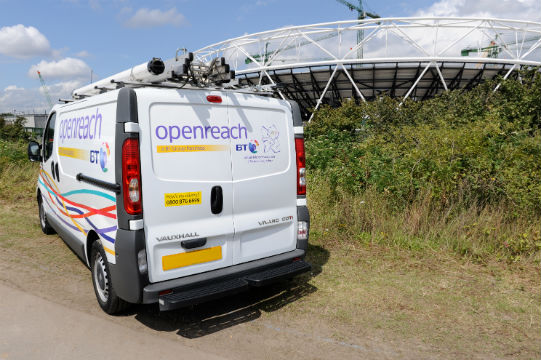BT To Trial Huawei G.FAST FTTdp Copper Broadband Technology

1Gbps broadband on the way with G.FAST and FTTdp, say Huawei and BT
Huawei and BT are to hold a technical trial of G.FAST fibre to the distribution point (FTTdp) technology that could make it possible to offer faster broadband speeds using existing copper infrastructure.
The majority of superfast broadband users in the UK receive Fibre to the Cabinet (FTTC), which requires the use of copper for the final few hundred metres. Faster services are available using Fibre to the Premises (FTTP), but this is more costly as it requires fibre to be deployed directly to homes and businesses.
The new option takes the fibre to a “distribution point” closer to the customer’s permises, and makes use of the shorter distance, to apply G.FAST technology, a faster version of DSL which can offer speeds of 1Gbps over a distance of up to 250 metres using copper, and deliver faster speeds without the expense and disruption caused by FTTP deployment.
Fibre to the distribution point
 Huawei says the typical drop cables in the UK are considerably shorter than the limit for G.FAST, meaning it is possible that optimum speeds can be achieved. The trial will be held at BT’s research and development centre at Adastral Park near Ipswich and will see just how the technology performs on BT’s network.
Huawei says the typical drop cables in the UK are considerably shorter than the limit for G.FAST, meaning it is possible that optimum speeds can be achieved. The trial will be held at BT’s research and development centre at Adastral Park near Ipswich and will see just how the technology performs on BT’s network.
FTTdp links can also be powered from the user’s home, it has been reported, reducing the complexity in the street furniture.
“The G.FAST trial has the potential to demonstrate how ultrafast bandwidth access may be more efficiently delivered to consumers and businesses,” says Tim Whitley, managing director of research and innovation at BT. “We will be observing the results of the trial with interest to see whether G.FAST technology could play a role in ensuring BT has the best network in the short, medium and long term.”
Huawei created its first G.FAST prototype in December 2011 and has been involved with the development of the International Telecommunications Union (ITU) G.FAST standard, the draft of which is due to be released by the end of the year.
“Copper wires remain an important resource to telecom carriers and are assets that have yet to be fully exploited,” says Gao Ji, Huawei chief strategy and marketing officer for Western Europe. “By utilising new copper wire technologies, such as Vectoring and G.FAST, carriers can make more efficient use of their resources and quickly implement bandwidth strategies, helping to achieve commercial success. “
Ofcom interest
Ofcom has been monitoring the development of FTTdp and has previously said it was keen on BT holding a trial of the technology.
“Installing FTTdp with the existing copper wire being used for the final few meters could be more cost effective than deploying fibre all the way to the premise,” said the regulator in July. “It is generally considered that FTTdp would be most effective when used with a developing technology called G.FAST, which can be thought of as an evolution of VDSL.”
However Ofcom warned it was likely to be several years before the technology was technically mature enough for commercial deployment.
The government has already pledged £530 million towards the rollout of fibre through the Broadband Delivery UK (BDUK) initiative and has targeted 99 percent coverage by 2018, with alternative technologies such as 4G potentially used to reach those in remote areas.
Do you know the history of BT? Try our quiz!